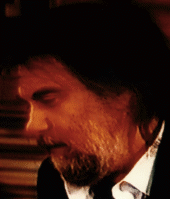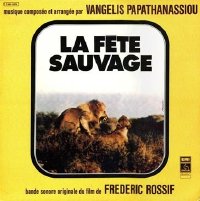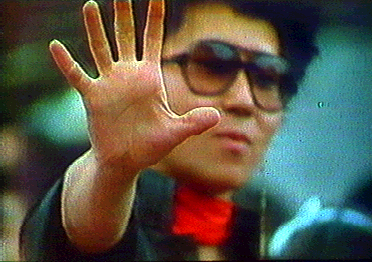
| The Electronic
Maestro How Vangelis changed movie music forever by Timothy Dugdale |
|
We
don’t often think of the anachronism in modern cinema. In
a postmodern age, nothing is incongruous. Bogie, resplendent in
his tux from Casablanca can be electronically resurrected
and put on a spaceship to Mars and we wouldn’t bat an eye.
Occasionally, a surprise comes along. For Synthesizers are old hat in Hollywood. They make it easy to sweeten an orchestra while lowering the cost. Thanks to digital sampling technology, anyone can imbue a score with a bit exotica, a gamalan here, a Shakuhachi flute there. Indeed, the synthesizer has thrived precisely because it no longer sounds like a synthesizer. Any of the old trademark sounds of a synthesizer come as standard patches on samplers so. Likewise, new software technology like ProTools and Garage Band allow composers to cut-and-paste scores from pre-made loops and licks. In a business as heartless and often headless as the motion picture industry, every artist intent on survival must either find a niche or make one. Vangelis has certainly done that. He has scored other sweeping historical pictures like The Bounty (1984) and 1492 (1992) to great effect. So it is perhaps wise to look at the way Vangelis composes to understand how he has managed to be such a recognizable presence. Vangelis Papathanassiou was born in 1943 in Volos, Greece. His earliest musical experience involved doctoring the guts of the family piano. Such adventures might have dissuaded him from more formal study of music. By the age of six, he bade farewell to the music teacher forever. As a teenager, he played in a number of pop bands in Greece, a knock-around existence that culminated in the unlikely stardom of "Aphrodite’s Child", a trio that specialized in emotional wrought bubblegum. In 1968, the band escaped to Paris from the coup in Greece but they were finished before the decade. Vangelis stayed in Paris where he began to collaborate with the French filmmaker Frederic Rossif. Rossif
was a documentarian who specialized in impressionistic wildlife
cine-essays, perfect venues for a multi-instrumentalist anxious
to leave pop music behind. Rossif used very sparse narration, often
with an elegiac conservationist tone (“Listen well, one day
all the animals imprisoned, humiliated, domesticated by man will
go far away from us to live once again in the promise of a savage
party”) leaving plenty of room for Vangelis to experiment.
Indeed, the scores for Rossif that have been released on audio disc
(Apocalypse Des Animaux, La Fete Sauvage, L’Opera Sauvage)
attest to the fealty of Vangelis refuses this model. After screening a film a couple of times, surrounded by his arsenal of keyboards, he improvises a complete soundtrack in one pass. As he can neither read nor write music, the recording tape is his score. By playing “live” to the film, there is little room for egomaniacal impositions on the essence of the film. There is a true and binding dialogue between Vangelis and the frames, manifest in the moment. It is an organic product that breathes on its own in and with the film. Flush with cash after landing a record deal with RCA, Vangelis purchased an old girl’s school in 1975 and converted it into his private sound laboratory. And museum. Not only was he an obsessive collector of keyboards, he kept on hand a menagerie of percussive and string instruments. This was long before the advent of the sampler in which sounds could be recorded digitally and then triggered from a keyboard. Chariots of Fire It has been said that Vangelis owes his Oscar to Giorgio Moroder who composed the soundtrack to Midnight Express, a winner at the Oscars the year before because. How ironic that Midnight Express was conceived and edited using existing music by Vangelis, pulled at the last minute due to contractual problems. The same music, I might add, that Carl Sagan used to great effect in his television series Cosmos. Moroder was best known as the producer/svengali of Donna Summer. But such a label does him a disservice. On Summer tracks such as “I Feel Love” and his own Eurodisco epic “From Here to Eternity”, Moroder injected real sensuality into rhythmic electronic music that had previously been the domain of German stiffs like Tangerine Dream and Kraftwerk. His score for Midnight Express is rife with that sensuality – very 70’s, very hedonistic, very reckless yet vibrant and feral. The pulse of the age is in the music. The score for Chariots of Fire was revolutionary precisely because it was able to speak to the moment yet shuttle us back to 1924. How is this possible? After all, the title theme, with its throbbing bass, clattering percussion, rousing synthetic horns and romantic piano lead has been reduced to a Hallmark Card that haunts lite FM radio, dentist’s offices, wedding chapels and cancer wards. But heard inside the film, Vangelis’ music is incandescent because it is so well situated in a larger musical structure. Period music abounds in this film. Glee club songs, Gilbert and Sullivan ditties and even Parry’s towering ode to Britain, “Jerusalem” appear. This is the music of the England in which the characters exist – music of churches, fraternities and theatres, institutions constrained and informed by the fading light of Empire and the gentlemanly delusions of the 19th century laid to rest in the bloody muck of WWI. Nostalgia is always shadowed by melancholy. The music of Vangelis belongs to their interior worlds -- their ambitions, their doubts, their convictions. And we see them ennobled by it. Lydell (Ian Charleson) runs in a race at a country fair held near his Scottish hometown. The music has the lilt of a local hymn yet also voices Lydell’s flailing ecstasy in competition. Abrahams (Ben Cross) wins the 100 metres in Paris. The race is shown at regular speed and then is repeated in slow motion accompanied by the theme music particular to the character. It is little more than a figure, a riff, rendered on a sonorous electric piano. In the background is a synthesized gull-like sound, reiterating at various rates. Simple, yes. But as Francis Rimbert, long-time collaborator of French electronic musician Jean Michel Jarre has noted, Vangelis is a mystic -– he can play three notes and it’s beautiful. In the very next shot, we are in the room of Abraham’s trainer barred from the competition because he is a professional. He listens rapturously as the strains of a band striking up the British national anthem reaches his window from across the street. The two sons of immigrants have triumphed, one on the inside looking out, the other on the outside looking in. The rich deep end of this score is courtesy of live timpani and trap drums, not to mention a titanic Steinway grand. Indeed, it is the acoustic elements of Vangelis’ instrumental ism that provide the portal through which the electronics bristle and surge across the years. One does not require suspended disbelief. We never feel the anachronism because it is effectively not there. At the film’s conclusion, when the thundering organ playing “Jerusalem” swells with the choir, it could well be Vangelis at the keys of a cheap toy organ that he has modified to sound epic. We don’t know and we don’t care. The illusion is complete.
Many
critics and academics have hailed this film as an exemplar of post
punk or cyber-punk cinema. Yes, the production design of the film
exploits a mishmash of visual tropes from Los Angeles 1945, 1982
and 2129. Yes, there’s a detective working the margins of
a society dominated by technology. I would argue, In contrast, the punks championed filth and noise. Their songs were provisional constructs that could self-destruct at any moment. Knowing how to play an instrument was not only unnecessary; it was unwelcome. Mistakes, bum notes and sundry audio fuck-ups had an air of revolution, a refusal of marketable perfection. Two years before he composed the score for Chariots of Fire, Vangelis released “Beaubourg”, a “suite inspired by the futuristic architecture of the Centre Pompidou, that singular Parisian edifice dedicated to modern art". It is a record that detractors call unlistenable because it has no discernable melodies. Yet this is the point. One is forced to engage the work, to go looking inside the abstract expressionism of the sound, to listen actively for the secrets in the noise. Thus, the score for Blade Runner is an extension of this sensibility –- the imposing yet beautiful netherworld between random noise and music. The
images that capture the essence of Vangelis’ score are not
in this film. Rather, one must consult the outer and inner sleeve
of his 1980 release, "See You Later". The former features
a young reedy Asian woman surveying a bleek washed-out landscape
through a pair of futuristic glasses. The latter is even more compelling:
a woman carries a child limp in her arms through a By removing both the unconvincing happy ending and the dreary hardboiled narration from the Director’s Cut, Ridley Scott did Vangelis a huge service. Imagine what damage would have done to Jerry Goldsmith’s dissonant, brooding score for Chinatown had Polanski caved into a happy ending? Los Angeles, at any age, is not an uplifting place so why should it sound like it? Narration gone, Deckard (Harrison Ford) is just another replicant. The film seems less a fiction with protagonists and plot than a documentary about humanoids and the world they’re forced to live in by nefarious humans. Vangelis is our emotional guide through the sonic jungle of the film. Every moment, machines and gizmos are chirping, beckoning and inquiring, producing an oppressive din. This of course is part and parcel of the hegemony of the Tyrell Corporation. But Mr. Tyrell is no ordinary tycoon. He enlists a motley crew of anachronistic artisans and craftsman -– a broken down Chinaman in a South Pole anorak, a sleazy Middle Eastern bar owner and a dog-yeared whiz kid -- to do his bidding in genetic design. Everything about their work seems jerry-rigged or fly-by-night, not surprising when you consider their respective laboratories, testaments to the ongoing decay of the city and the lack of first rate manpower. Thus the most compelling moment of Vangelis’ score can be found in the sprawling Dickensian apartment of J.F. Sebastien when Roy appears to tell Pris the bad news that they’re down to two. Pris has been softening up the shy J.F. In the background, a cuckoo clock squawks its wisdom. What sounds like a worked over music box begins to play, barely breaking through the chatter of J.F.’s toys. When Roy arrives, the music box melody is lost for a moment as he relates the recent demise of Zora and Leon. Pris replies “Then we’re stupid and we’ll die.” Roy reassures her with a kiss and the music box theme returns, this time richer and more poignant. In this one brief sequence, Vangelis quietly and expertly expresses the existential malaise of these three unfortunate creatures who have little time to live. Circumstances are beyond their control, both inside and outside of their bodies. None of them had a childhood nor will they enjoy golden years dozing in the sun. The music is a wistful eulogy, from the toys to them. The one piece of technology that does not speak until it is spoken to is the piano shipwrecked in Deckard’s apartment. Neither Deckard nor Rachel know how to play it. Rachel wonders aloud if she can or if she is merely reproducing the music lessons (a tip of the hat to the old truant Vangelis?) of Tyrell’s niece. There is a gallery of antique photographs atop the piano. Relatives of Deckard’s or more memory implants? Why this pointless evocation of the 19th century drawing room? The anachronisms of the piano and the photos speak to a world long gone when people had control over noise and their inner thoughts. Memory and imagination could thrive. In that sense, “Memories of Green” is the siren song of ghosts, speaking to an uncertain past. When Deckard takes the Polaroid of Leon’s apartment and starts dissecting the thing with the help of a bleeping black box, we see the obliteration of the interior world by the mastery of technology. Nothing is unseen, nothing unknown, no mystery. No memory. The producer Quincy Jones has noted that black musicians had no interest in the synthesizer until the pitch bend wheel appeared, making experimentation with the “blue note” possible. Nobody knows more about this than Vangelis. The perennial flagship of his arsenal is the Yamaha CS-80, a relic from the late seventies. But at the time of its release, it was the apotheosis of analogue synthesis. Weighing more than 200 lbs., the CS-80 featured a weighted keyboard that mimicked the subtlety of a piano’s action. The electronics allowed for the real-time adjustment of many different parameters and effects. Also onboard was a ribbon-controller, which sat just above the keyboard. For Vangelis, this one feature was a godsend, allowing him to flirt with utter sonic chaos one moment, only to slide his finger along the ribbon to release an entirely opposite voicing of rich, melodious strings. The Blade Runner score was a valedictorian moment for the CS-80. By 1982, it was fast becoming a dinosaur. Yamaha failed to follow up on its promise, choosing instead to produce synthesizers that produced sound based on algorithms. From a performance standpoint, this was a disaster. The new machines allowed very little modification of pre-set sounds and what modification was available could only be accomplished by scrolling through time-consuming menus on a tiny LCD screen. The sound was too clean, too bright. Everybody bought the same machines and used the same presets. The synthesizer became little more than a souped-up organ, perfect for new wave and arena rock music of the 80’s. Only in the later part of the decade would old synthesizers reappear in the warehouses of Chicago and Detroit where techno was being birthed.
One could say that Vangelis has considerable blood on his hands. The success of The Chariots of Fire soundtrack proved that there was money was in the synthesizer outside of rock. Yanni and John Tesh and countless other purveyors of audio anesthesia owe their lives in the New Age and Lifestyle bins of record stores to Vangelis. Indeed, the subdued yet uplifting tone of the Chariots soundtrack arrived as just the moment when millions of people needed it: the eighties and the nineties would be a long hard psychic slog and people would need soothing sounds to cope with the va-va-voom of stock market booms and bust. If Chariots of Fire served as the touchstone of one generation’s sonic therapy, Blade Runner fit the bill for another. Dozens of chill-out and trance mixes by various Djs (e.g. Paul Oakenfold’s “Another World”) use tracks from Blade Runner both for atmosphere and gravitas. Blade Runner, as mentioned earlier, is the apotheosis of analog synthesis that carries with it the alluring oppositionality of the film’s cyberpunk ethos. It is quintessentially “old school”. The shifting, ambiguous categories of the current electronic scene music – ambient techno, downbeat, etc. – reflect the quixotic attempt of youth culture to maintain some sort of taxonomy for itself while staying one step ahead of the music industry. Blade Runner stands outside of that system and as such merits reverence. As Neal Gabler notes in his book, “Life, the Movie”, many people in the developed world have turned to the cinema less for validation of their own experiences than for clues how to live more like cinema. Much of current electronic music is really lifestyle music -– music for sipping martinis in lounges, music for dancing in clubs, music for chilling at your space age bachelor pad. The overarching yet unspeakable collective imperative is that life is a production that must be scored for potential viewing. Elvis Mitchell, in his review of Lost in Translation, notices signs of a generational affectation of loneliness. As Charlotte (Scarlett Johanson) admits to Bob (Bill Murray), “I’m stuck”. Kevin Shields’ score has very little to do with the middle aged travails of Bob. Shield’s music is an articulation of Charlotte’s momentary dislocation from America and her seemingly more permanent dislocation from her husband and his tolerance of the stupidities of their generation. The self-conscious crosstalk between the melancholic, tonal score and the sound design of the film (the whispered, manicured hush of the hotel, the ringing of phones and fax machines, the incessant clicking of cameras, talking billboards, chiming arcades etc) deeply echoes Blade Runner’s moody portrayal of urban hyper-mediation. The future is here, alive and well in Tokyo. And youth have to live with it, much to their mopey chagrin. Indeed, when Charlotte takes a bullet train ride to Kyoto, the sequence is accompanied by the French band Air’s “Alone in Kyoto”. The music begins with random electronic noise from which emerges a guitar and a ringing gong-like lead. This is modern life in globalization. The familiar and the exotic, noise and music. But
wait, haven’t we seen or rather heard this before? Chris Marker’s
1982 cine-essay Sans Soleil spends a great deal of time
exploring Tokyo as a site of “hyperdevelopment”. He
takes us to temples and arcades and trains, all the while In the film, Marker also visits Africa, long considered chronically “underdeveloped”. The trickster synthesizer tags along, unflagging in its chirps and gurgles. The central thesis of the film, it seems, is the inconsolable and unbridgeable gap between the first and third worlds. In Blade Runner, Vangelis’ score articulated the existential quandary of individuals, replicant and human, fighting for breathing room in a corporate world so ruthless and dominating that it had given up on the planet as a human project. The future of man is in space. Earth is left as a graveyard of progress. Marker’s film is profoundly melancholic because Japan, caught between feudal heritage and modernist ambitions, races onward into an uncertain and uneasy hybrid of the two. The “climax” of the film involves a vintage stock footage of kamikaze pilots dive-bombing American battle ships. The images have been run through a video synthesizer, rendering the old black-and-white footage vivid red and orange. In the background, one hears Sibelius’ “Valse Triste” played by reknown Japanese synthesist Isao Tomita. It is as if we were watching a moment of cultural fission during which the old Japan annihilates itself and the modern is born in the primal violence of the explosions. The final image of the film is brief – a hand unplugs the synthesizer (a vintage VCS3) and holds the pin in the air. But what is the gesture? Triumph? Defiance? Or admission of defeat? This is the true legacy of Vangelis’ score for Blade Runner. The synthesizer, far from being inhuman and cold, acts as the synapse between incompatible ideas and conditions. Marker, so fixated on memory and history, continues to use the white noise of the analogue synthesizer as trickster, confounding the process of making sense of a world that so often rebuffs these efforts in strange and beautiful ways. --
Timothy Dugdale |

| |
 |
Euro Screen Writers Articles on Euro film, research, plus a great cache of interviews with such directors as Godard, Besson, Agnieszka Holland, Peter Greenway, and Fritz Lang. |
 |
Done Deal: A current list of the latest industry script sales. |
 |
UK's Film Unlimited Truly unlimited, one of the best film sites going. Plenty of news, reviews, special reports, features, and PREVIEWS. |
 |
Screen Writer's Utopia! What are they, who wrote them, who's doing them, and what you can expect. |
 example, Oliver Stone has signed the Greek composer Vangelis to
score his next film, Alexander the Great. With Stone at
the helm, the picture is sure to be a hyperventilating epic, bigger
than life, than history itself. Why would Stone commission a score
from a man who works almost exclusively with electronic instruments?
It does not compute, as it were.
example, Oliver Stone has signed the Greek composer Vangelis to
score his next film, Alexander the Great. With Stone at
the helm, the picture is sure to be a hyperventilating epic, bigger
than life, than history itself. Why would Stone commission a score
from a man who works almost exclusively with electronic instruments?
It does not compute, as it were.  composer
to the philosophical intent of the filmmaker yet also reveal the
latitude such non-conventional cinema allowed. The amazing thing
about these scores is the speed at which they were composed. One
has to return to silent film era to understand Vangelis’ unique
method. In those days, pianists and organists either improvised
on the spot or mined the current hit parade. The talkies killed
their business. Movie music was atomized into cues, often afterthoughts
to the main production.
composer
to the philosophical intent of the filmmaker yet also reveal the
latitude such non-conventional cinema allowed. The amazing thing
about these scores is the speed at which they were composed. One
has to return to silent film era to understand Vangelis’ unique
method. In those days, pianists and organists either improvised
on the spot or mined the current hit parade. The talkies killed
their business. Movie music was atomized into cues, often afterthoughts
to the main production.  however,
that the score to Blade Runner is certainly punk if not
in body then spirit. When I think of the Sex Pistols, I imagine
that pivot scene in 2001 A Space Odyssey, where the ape
throws the bone into the air and the match cut reveals a space station,
playing in reverse. The Pistols tried to take rock back to the cave.
They were reactionaries, moving against the bloated and the banal
of the music industry. The synthesizer, once the domain of experimental
classical music, was part of the problem. Bands such as Yes and
ELP were using it to either fulfill their musical pretenses or to
provide sonic filler when pretenses failed them. Their music was
horribly white and antiseptic thanks to meticulous musicianship
and overproduction.
however,
that the score to Blade Runner is certainly punk if not
in body then spirit. When I think of the Sex Pistols, I imagine
that pivot scene in 2001 A Space Odyssey, where the ape
throws the bone into the air and the match cut reveals a space station,
playing in reverse. The Pistols tried to take rock back to the cave.
They were reactionaries, moving against the bloated and the banal
of the music industry. The synthesizer, once the domain of experimental
classical music, was part of the problem. Bands such as Yes and
ELP were using it to either fulfill their musical pretenses or to
provide sonic filler when pretenses failed them. Their music was
horribly white and antiseptic thanks to meticulous musicianship
and overproduction.  greenhouse.
They are both wearing gas masks. One is hardly surprised that the
centerpiece of the album is a track called “Memories of Green”.
As Vangelis takes a moody and bluesy ramble up and down his beloved
Steinway as it is fed through a cheap effects pedal, a studio assistant
plays “live” an early version of a Gameboy (That old
punk svengali Malcolm McLaren is in the process of co-opting the
second “wave” of punk in what he calls “chip music”.
Old 8bit Gameboys are now reprogrammed to play music, a reaction
against ProTools and the fetish of analogue synthesis in techno).
Occasionally, Vangelis dispatches a discreet squall of sample-and-hold
white noise. The overall effect is mesmerizing – the music
seems at once futuristic and old, as if the composer, like the dazed
fugitive in “The Pianist”, happens upon a piano in the
midst of post-apocalyptic ruins. Moreover, there is a real tension
between harmony and dissonance; neither has the upper hand. The
piano appears and then disappears into the ether of beeps and sirens
without warning.
greenhouse.
They are both wearing gas masks. One is hardly surprised that the
centerpiece of the album is a track called “Memories of Green”.
As Vangelis takes a moody and bluesy ramble up and down his beloved
Steinway as it is fed through a cheap effects pedal, a studio assistant
plays “live” an early version of a Gameboy (That old
punk svengali Malcolm McLaren is in the process of co-opting the
second “wave” of punk in what he calls “chip music”.
Old 8bit Gameboys are now reprogrammed to play music, a reaction
against ProTools and the fetish of analogue synthesis in techno).
Occasionally, Vangelis dispatches a discreet squall of sample-and-hold
white noise. The overall effect is mesmerizing – the music
seems at once futuristic and old, as if the composer, like the dazed
fugitive in “The Pianist”, happens upon a piano in the
midst of post-apocalyptic ruins. Moreover, there is a real tension
between harmony and dissonance; neither has the upper hand. The
piano appears and then disappears into the ether of beeps and sirens
without warning.  allowing
the chaos of Tokyo to fill the soundtrack. Behind that wall of sound
is another front of noise, the product of an analogue synthesizer
constantly unleashing squalls of random notes and the occasional
hint of melody.
allowing
the chaos of Tokyo to fill the soundtrack. Behind that wall of sound
is another front of noise, the product of an analogue synthesizer
constantly unleashing squalls of random notes and the occasional
hint of melody. 